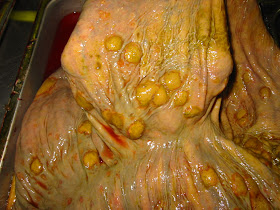The radiographic image below is of the right hind pastern of a 4 year old mare that presented for a prepurchase exam. The mare had only been under saddle for 6 months. During the active exam, the mare cross-cantered when lunged to the left. In addition, the pastern area was "thicker" when compared to the opposite hind limb and the mare was moderately positive to flexion of the limb in question. Due to the suspicion of a significant problem, the right hind pastern was radiographed. The yellow arrows highlight new bone growth along the edges of the pastern joint. The bone growth or osteophytes are large and proliferative. These findings are indicative of advanced osteo-arthritis of the pastern joint otherwise known as "high ring bone".
 |
| Figure 1 |
In Figure 2, the same osteophytes are noted as the course around the front of the pastern joint. The yellow arrows point to the osteophytes or irregular "white" structures along the edge of the pastern joint.
 |
| Figure 2 |
Figure 3 and 4 are radiographs of a normal pastern joint. There are no osteophytes noted along the margins of the pastern joint. Notice in Figure 4 the smooth, curved border of the normal pastern joint. Interestingly, the pastern imaged in Figures 3 and 4 was radiographed because it palpated "thicker" than the opposite limb. Fortunately, there was no evidence of pastern arthritis.
 |
Figure 3
|
 |
Figure 4
|
In Figure 5 there is significant new bone growth or osteophyte development along the margins of the coffin joint. This is known as "low ring bone". Generally speaking, "high" or "low" ring bone is a significant finding during a prepurchase exam. Low ring bone is more common in draft breed horses. In addition, varying degrees of coffin joint arthritis, in active sport horses, is more common than pastern arthritis.
 |
| Figure 5 |
High ring bone or pastern arthritis should be a concerning finding in any horse that is expected to carry a rider. Medical management of pastern osteoarthritis is limited to intra-articular treatment with cortisone or regenerative therapies. Unfortunately, the degeneration of the joint progresses rapidly and commonly results in chronic lameness. Surgical management involves fusion of the joint either with hardware or chemicals.


















































